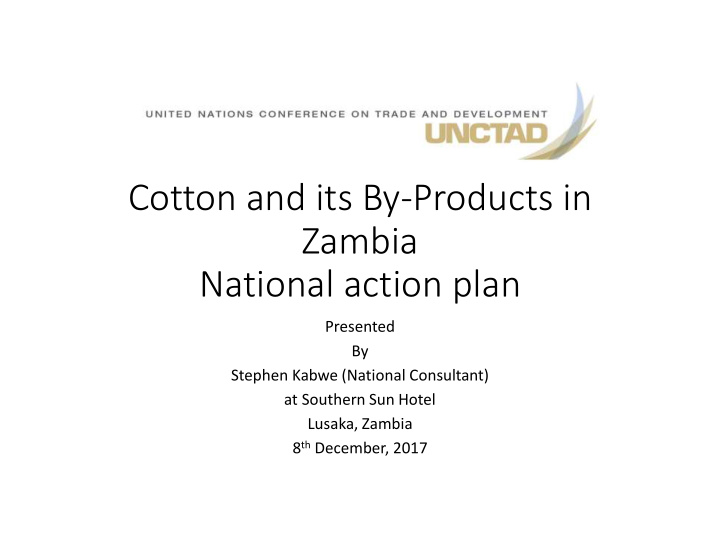



Cotton and its By-Products in Zambia National action plan Presented By Stephen Kabwe (National Consultant) at Southern Sun Hotel Lusaka, Zambia 8 th December, 2017
Road Map Key policy issues that may affect the development National Action of cotton sector plan Cotton by-products identified for piloting Background information and cotton by-product 2
Background Cotton remains an important cash crop - 2 million smallholder farmers in Sub Saharan Africa Source of income for rural households, employment opportunities for people, source of export revenue for government Cotton grown mainly for LINT but there are by-products that can be derived from cotton: cake, edible oil, soaps, margarine, particle boards etc
Knowledge Gap • Despite the value added potential on cotton by-product, this Underde value chain is underdeveloped in Africa veloped • UNCTAD, ECA and COMESA designed a project to assess the development of cotton by-product value chain in Tanzania, Project Uganda, Zambia and Zimbabwe • Improve capacity of cotton value chain stakeholders in assessing market opportunities and challenges • Improve capacity of policy makers in Zambia to formulate Objective evidence-based policies that help develop cotton by-product s industries
Cotton plant Source: CAZ 2017
Cotton Plant Seed Cotton Stalk Cotton Lint Cottonseed 35-41% weight of seed cotton 55-65% weight of seed cotton Focus of UNCTAD Project Promoting cotton by-product in Eastern and Southern Africa
Area, Production of Seed Cotton and by Products Nu Area and Product Quantities 1 Area Under Cotton (ha) 100,000 – 130,0000 2 Seed cotton production (MT) 85,000 – 110,000 3 Cotton lint (MT) 34,850 – 45,100 4 Cottonseed (MT) 46,750 – 60,500 5 Linters (MT) 2,805 – 3,630 6 Cottonseed hulls (MT) 10,285 – 13,310 7 Cottonseed oil (MT) 7,480 – 9680 8 Cottonseed meal (MT) 25,713 – 33,275 9 Cotton stalks (MT) 300,000 – 390,000 Source: Central Statistics Office CFS
Selected Cotton by-Products for Piloting • Absorbent cotton (surgical/sanitary pads) • Ermine Enterprises – Lusaka • Premier Cooperatives • Cotton stalks • Pilot briquetting plant • Pilot pelleting plant • Mushroom making • Compost
National action plan for the development of the cotton by- product • Finalize and submit the proposal to MCTI by January 2018 • Oversight Committee created and will be supervised by PS MCTI • Possible sites for cotton stalks projects (Chipata and Mumbwa)
Key Issues that may affect cotton sector development Nu Key Policy Issues Possible Solutions 1 Low productivity and production of seed cotton Robust plan to improve low productivity 2 High variable prices Lobby for establishing a stabilization fund 3 Maize centric policies Lobby government to also focus more on cotton 4 Taxes and VAT Lobby government 5 Lack of incentives to attract investment in value addition Engage government to look at incentives that may attract investment 6 Regulation that is only focused on cotton production Review and update the Cotton Act to increase the mandate of CBZ 7 Lack of centre of Excellence for cotton production and value addition Lobby government and other cooperating partners to develop CDT to that level
Evolution of the cotton sector 600000 1,20 Seed cotton production (mt) and Seed cotton yield (mt/ha) and 500000 1,00 400000 0,80 price (USD/kg) area (ha) 300000 0,60 200000 0,40 100000 0,20 0 0,00 1996199719981999200020012002200320042005200620072008200920102011201220132014201520162017 Years Seed cotton Production (mt) Area harvested (ha) Seed cotton Yield (mt/ha) Seed cotton price (USD) Source: CSO/CBZ
Thank you
Way forward By-Products Key challenges Key challenges Possible Solutions Feedstock • Particles Particles boards In the law it is not written that farmers cannot cut Cotton stalk boards and sell the cotton stalks • Law (Cap 233 Plant Pest and Diseases) • Need to look at affordable technologies farmers can Pellets Pellets major impediment use at that level (chipping technologies), affordable • Lack of appropriate technologies Paper Paper factory equipment for making pellets and particle boards To enhnce Seed cotton Production • Low seed cotton production affects • Harmonized extension services, promote use of consistency supply • Animal stockfeed VAT on cottonseed fertilizer Cottonseed • • Limited only for ruminants because of Introduction of price stabilization fund Cottonseed meal cake • gossypol Improved funding to research institution eg CDT to provide improved varieties Fertilizer • Lack of appropriate technology • Strengthen extension provision (private/public) • Promote the use of climate smart agricultural • Edible oil Importation of cheap edible oils practices • Margarine Not developed, but low quantity of • Organize farmers in Cooperatives (eg model under Cottonseed feedstock oil CAZ) • Improve regulations (Cotton Act) • Soap Color and low quantity of feedstock • Offer tax incentives for inputs for seed cotton Added a roughage Hulls production hulls to animal stockfeed By-Products • Advocate for remove of VAT on cottonseed Food packaging, • • Low seed cotton production affects Apply appropriate taxes that can curb importation of currency consistency supply refined oil Linters • VAT on cottonseed • Government to improve monitoring boarders points Linters to curb smuggling of cheap oils • Develop strong relationship with cattle farmers (dairy)
Recommend
More recommend